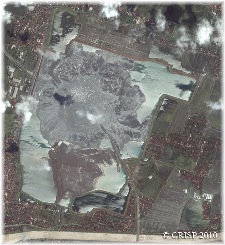
Two and a half years ago, the Society hosted a meeting to debate the possible causes of the LUSI mud volcano, which has been spewing mud continuously since 2006. Now, for the first time, a detailed study published in the Journal of the Geological Society has estimated how long the mud will continue to be hazardous, suggesting it will be 26 years before the inhabitants of Sidoarjo, a subdistrict of Porong in Eastern Java, Indonesia, can expect LUSI to calm down into ‘a slow, bubbling volcano’.
Geoscientist online, 25 February 2011
LUSI is the world’s biggest mud volcano, at its height producing enough mud daily to fill 50 Olympic-sized swimming pools. When it first erupted in 2006, thirteen people were killed and thirteen thousand families were displaced. Scientists from the University of Durham have predicted that another 56,000 Olympic-sized swimming pools worth of mud have yet to be emitted, which could cause the area to subside by as much as half a kilometre.
‘Our estimate is that it will take 26 years for the eruption to drop to a manageable level and for LUSI to turn into a slow bubbling volcano’ says Professor Richard Davies of the Department of Earth Sciences at Durham.
‘The calculation should enable a better assessment of the final impact of the disaster and gives the inhabitants of Sidoarjo an indication of how long they can expect to be affected by mud from the volcano’.
The estimate was made by using pressure estimations from a nearby borehole, as well as knowledge of the inner workings of the volcano itself and observations of the eruption so far. The 26 year estimate is the time expected for the volcano’s mud flow to fall to 10% of its initial flow rate, although it does not factor in the further complications of the effects of gas in the mud, which could ignite and keep the eruption going even longer.
The eruption, which began on 29 May 2006, took place just 200 metres from the head of a hydrocarbon exploration well. The name ‘LUSI’ was derived from the first two letters of ‘Lumpur’ (mud) and ‘Sidoarjo’, an area which has been devastated by the eruption, with homes, factories and farming land destroyed.
Those who blame the well for the subsequent disaster argue that it penetrated overpressured limestones and, with no casing protecting the lower 1,743 metres of the well, allowed for free communication between the borehole’s fluids and the limestone, as well as the sand and mud above. Davies has argued that this caused a ‘kick’ in the well, causing pressure to be released at the surface.
Lapindo Brantas, the drilling company responsible for the well, have disputed this claim, arguing that the magnitude 6.3 earthquake which took place two days before the LUSI eruption began, and 280 km away, was its trigger. At the Geological Society meeting, the majority concluded that the drilling was responsible.
Whatever the cause, efforts to stem the flow of mud, which have included plugging the crater with concrete balls, have so far failed, and most of the mud flow is currently being contained by giant dams. As the land subsides, more vents are opening up. These, which number 166 so far, are likely to be caused, says Davies, by the rupturing of shallow aquifers. The team are now looking at where these vents are likely to form next, since they believe they may cause further damage to homes and transport infrastructure.
‘The world demand for oil and gas has inherent risk’ says Davies, ‘and while exploration may reap dividends, it can also cause problems. Drilling disasters are more common than people generally appreciate’.
Professor Davies plans to visit the volcano in May to carry out further research.
- Journal reference: Davies, R. J. et al., 'Probabilistic longevity estimate for the LUSI mud volcano, East Java', Journal of the Geological Society, Vol. 168, Issue 2, pp. 517-524.